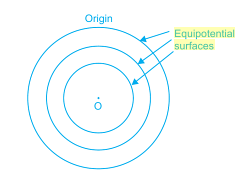Ask questions which are clear, concise and easy to understand.
Ask QuestionPosted by Jay Prakash 5 years, 7 months ago
- 1 answers
Posted by Abhimanyu Singh 5 years, 7 months ago
- 0 answers
Posted by Sukriti Singh 5 years, 7 months ago
- 1 answers
Meghna Thapar 5 years, 7 months ago
Intensity is defined to be the power per unit area carried by a wave. Power is the rate at which energy is transferred by the wave. In equation form, intensity I is I=PA I = P A , where P is the power through an area A. The SI unit for I is W/m2. Electric field intensity is the strength of an electric field at any point. It is equal to the electric force per unit charge experienced by a test charge placed at that point, or E=qF. From Gauss law, considering a spherical surface with charge at its center as Gaussian surface, E(A)=ϵ0q.
Posted by Banu Priya 5 years, 7 months ago
- 0 answers
Posted by Banu Priya 5 years, 7 months ago
- 1 answers
Yogita Ingle 5 years, 7 months ago
Electric charge is a physical property of matter that causes it to experience a force when kept in an electromagnetic field. Positive and negative are the two types of electric charges, commonly carried by charge carriers protons and electrons. When the net charge of an object equals to zero, the object is said to be neutral.
Posted by Anushka Shrivastava 5 years, 7 months ago
- 1 answers
Rohit Krishna 5 years, 7 months ago
Posted by Geeta Kumari 5 years, 7 months ago
- 3 answers
Rahul Mehra 5 years, 7 months ago
Yogita Ingle 5 years, 7 months ago
Forces between multiple charges –Superposition principle
As per the principle of superposition, the force on any charge due to a number of other charges is the vector sum of all the forces on that charge due to other charges, taken one at a time.

Yogita Ingle 5 years, 7 months ago
Forces between multiple charges –Superposition principle
As per the principle of superposition, the force on any charge due to a number of other charges is the vector sum of all the forces on that charge due to other charges, taken one at a time.

Posted by Geeta Kumari 5 years, 7 months ago
- 1 answers
Posted by Jass . 5 years, 7 months ago
- 2 answers
Yogita Ingle 5 years, 7 months ago
Area vector is a vector whose magnitude is equal to the area and is directed normal to the surface.
Area as such is a scalar. So, Area vector is defined as above for use in calculations and defining some other terms like torque on a current carrying loop in a magnetic field etc.
Posted by Suhoka Lee 5 years, 7 months ago
- 0 answers
Posted by Narendra Nagarkar 5 years, 7 months ago
- 1 answers
Meghna Thapar 5 years, 7 months ago
The electrical potential difference is defined as the amount of work done to carrying a unit charge from one point to another in an electric field. In other words, the potential difference is defined as the difference in the electric potential of the two charged bodies.
Posted by Harish Harish 5 years, 7 months ago
- 2 answers
Gaurav Seth 5 years, 7 months ago
The equipotential surfaces, for an isolated point charge are concentric spheres whose centres are located at the given point charge.

Posted by Rohit Krishna 5 years, 7 months ago
- 1 answers
Devil ? 5 years, 7 months ago
Posted by Vaibhav Singh 5 years, 7 months ago
- 2 answers
Ayush Vishwakarma?? 5 years, 7 months ago
Rohit Krishna 5 years, 7 months ago
Posted by Riya Bhanwala 5 years, 7 months ago
- 1 answers
Posted by Asavari Kaur 5 years, 7 months ago
- 1 answers
Posted by Rohit Krishna 5 years, 7 months ago
- 1 answers
Yogita Ingle 5 years, 7 months ago
Drift velocity is defined as the average velocity attained by the particles (electrons) of a given material due to an electric field which is proportional to current. Ohm’s law can be expressed in terms of drift velocity as follow:
u=μE
Where,
u: drift velocity (m/s)
μ: material’s electron mobility (m2/V.s)
E: electric field (V/m)
Posted by Arun Singh 5 years, 7 months ago
- 0 answers
Posted by Rinku Sheoran 5 years, 7 months ago
- 1 answers
Posted by Gokul Prasanth G 5 years, 7 months ago
- 1 answers
Alen Saklani 5 years, 7 months ago

myCBSEguide
Trusted by 1 Crore+ Students

Test Generator
Create papers online. It's FREE.

CUET Mock Tests
75,000+ questions to practice only on myCBSEguide app
 myCBSEguide
myCBSEguide
Rohit Krishna 5 years, 7 months ago
1Thank You